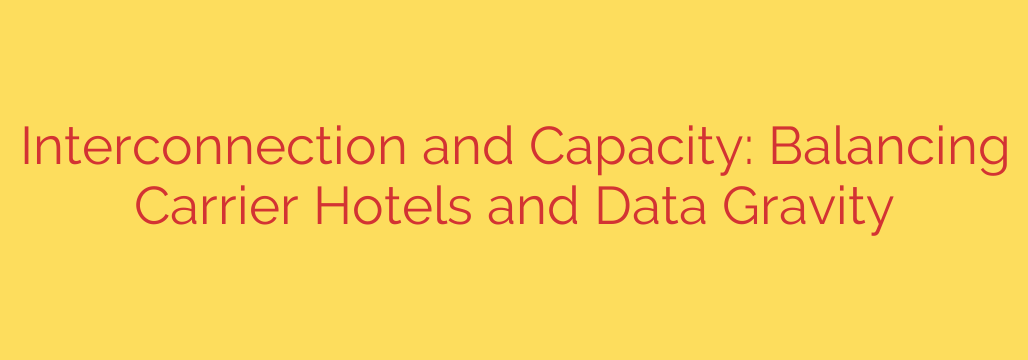
The Data Center Dilemma: Balancing Low-Latency Interconnection and Massive Scalability
In today’s digital economy, businesses face two powerful and often conflicting infrastructure demands. On one hand, you need lightning-fast, low-latency connections to a rich ecosystem of partners, clouds, and carriers. On the other, you need vast, scalable space to accommodate the ever-growing “gravity” of your data and applications.
For years, the solution to the first demand was the carrier hotel—a dense, city-center hub teeming with network providers. To solve the second, businesses turned to sprawling, purpose-built data centers with immense capacity. The problem? These two solutions often exist in different locations, forcing a difficult choice between connectivity and capacity.
Fortunately, you don’t have to choose. A modern, hybrid approach allows you to leverage the best of both worlds, creating a digital infrastructure that is both agile and immensely powerful.
The Power of Proximity: Understanding the Carrier Hotel
Think of a carrier hotel as the Grand Central Station of the internet. These facilities, typically located in the hearts of major metropolitan areas, are the physical meeting points for hundreds of different network carriers, cloud providers, and content delivery networks (CDNs).
The primary advantage of being in a carrier hotel is unparalleled interconnection. By placing your networking equipment here, you gain:
- Low-Latency Access: Direct, physical connections to partners and providers drastically reduce the time it takes for data to travel, which is critical for real-time applications, financial services, and media streaming.
- A Rich Ecosystem: You can easily establish connections with a massive variety of service providers, enabling multi-cloud strategies, diverse network peering, and direct access to business partners all within the same building.
- Network Resilience: With so many carriers to choose from, you can build a highly resilient network architecture that can withstand outages from any single provider.
However, carrier hotels have inherent limitations. They are often older buildings in expensive real estate markets, which means that space and power are finite and costly. Scaling a large compute or storage footprint in a carrier hotel is often impractical or prohibitively expensive.
The Unstoppable Force: The Challenge of Data Gravity
Data gravity is the concept that as a body of data grows, it becomes more difficult and costly to move. Consequently, it exerts a “pull,” attracting applications, services, and other data to it. As businesses embrace AI, machine learning, and big data analytics, their data sets are exploding in size, creating immense data gravity.
Accommodating this requires an infrastructure built for capacity. This means:
- Massive Scalability: The ability to add racks of servers, storage arrays, and high-density compute without worrying about physical space constraints.
- Abundant Power and Cooling: High-performance computing and dense storage generate enormous amounts of heat and consume significant power, requiring specialized facilities to support them.
- Cost Efficiency at Scale: Large-scale data centers, often located in suburban or rural areas, offer power and space at a much lower cost than a downtown carrier hotel.
The challenge is that these large-capacity campuses may not offer the same dense, low-latency interconnection ecosystem found in a carrier hotel.
The Solution: A Hybrid Strategy for the Best of Both Worlds
Instead of choosing between interconnection and capacity, the optimal strategy is to use them together. This hybrid IT approach involves strategically separating your infrastructure based on its function.
The model is simple yet powerful:
- Establish an Interconnection Hub: Place your core networking equipment—your “network edge”—inside a carrier hotel. This presence is compact but powerful, focused entirely on managing low-latency connections to your critical partners, cloud on-ramps, and internet carriers.
- Build a Capacity Core: House your large-scale compute, storage, and data-heavy applications in a larger, purpose-built data center. This is where your data gravity resides, giving you the freedom to scale without the constraints of a downtown facility.
- Create a Superhighway: Link your interconnection hub and your capacity core with secure, high-speed, private fiber connectivity. This dedicated link acts as a seamless extension of your network, ensuring that traffic can move quickly and reliably between your edge and your core.
This distributed architecture gives you the low-latency performance of a carrier hotel combined with the limitless scalability and cost-effectiveness of a large-scale data center.
Actionable Steps for a Future-Proof Infrastructure
To implement this resilient and scalable strategy, businesses should focus on a few key actions:
- Audit Your Workloads: Identify which applications are latency-sensitive and which are capacity-intensive. This will help you decide what belongs at the network edge versus the data core.
- Map Your Ecosystem: Understand the physical locations of your key partners, customers, and cloud providers to choose the most strategic carrier hotel for your interconnection hub.
- Prioritize Secure Connectivity: The link between your facilities is critical. Opt for private, dedicated fiber connections rather than relying on the public internet. This enhances both performance and security by keeping your core traffic off shared networks.
- Plan for Growth: Choose a capacity-focused data center partner that can grow with you, offering a clear path to adding more space and power as your data needs evolve.
By moving beyond the either/or debate, you can design a digital infrastructure that is perfectly balanced—delivering premier performance today and positioned for the demands of tomorrow.
Source: https://www.datacenters.com/news/interconnection-vs-capacity-the-balancing-act-in-carrier-hotels-and-data-gravity








